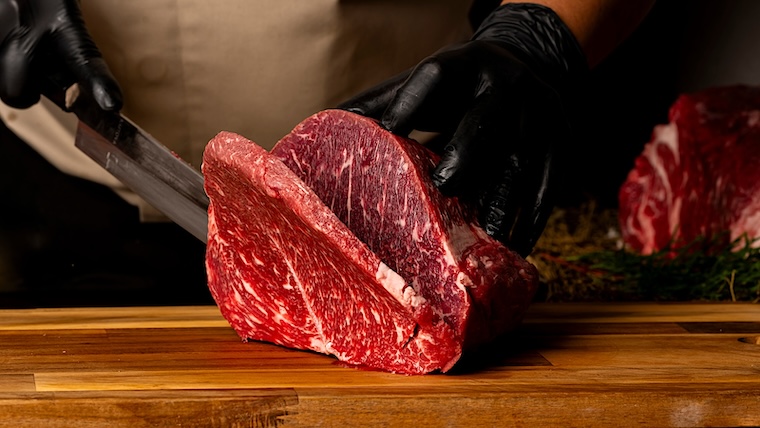Red meat — such as pork, beef, goat, veal, mutton, and lamb — is a rich source of protein and vital nutrients that aid muscle growth and hormone production. Yet, its impact on gut health remains a topic of debate, leaving many to wonder: Is red meat a friend or foe?
Thomas DeLauer, a renowned nutrition coach, health author, and celebrity trainer, recently weighed in. On Jan. 6, 2025, DeLauer delved into the relationship between red meat and gut health, drawing insights from scientific research to share his perspective.
[Related: Latest Meta-Analysis on Training Frequency for Hypertrophy]
A Study on Red Meat
DeLauer highlighted contrasting findings of two studies on red meat consumption from different world regions. The first study, published in The American Journal of Clinical Nutrition, examined red meat consumption among Asian populations and found a correlation with reduced cardiovascular disease.
By contrast, research on American consumers revealed that a higher intake of processed red meat was linked to an increased risk of cardiovascular disease and diabetes. These conflicting results raise essential questions about dietary habits, regional differences, and their impact on health. (1)
“That’s wild because current atherosclerosis reports [show] Americans [consume] more processed red meat, resulting in an increased mortality from cardiovascular disease as well as diabetes,” DeLauer said.
DeLauer compared American and Asian dietary habits. In Asian cultures, red meat is consumed more sparingly than in American diets, often involving red meat in less nutritious combinations like burgers, fries, and milkshakes. According to DeLauer, these kinds of combinations can lead to inflammatory responses.
How Does Meat Affect Gut Health?
N-Glycolylneuraminic acid (Neu5Gc) is used to evaluate how red meat impacts gut health. Neu5Gc is a type of sialic acid produced by most mammals that humans consume as food. While humans produced this compound millions of years ago, a genetic mutation eventually stopped its production.
Many plant-based advocates argue that red meat is harmful due to the body’s unusual immune response. DeLauer, however, suggests that this reaction may be linked to Neu5Gc. A healthy gut should prevent Neu5Gc from being absorbed into the body, potentially mitigating this response altogether.

While we cannot address it chemically, our microbiome can handle it. The hormetic curve illustrates that a certain stress level is essential for the body to adapt and thrive.
“It’s no different than popping in an ice bath to get an adaptation, or going in the sauna to adapt to heat, or even a bit of alcohol,” DeLauer explained.
A study that fed mice a diet high in Neu5Gc for four weeks showed results of increases in Bacteroides and clostridial bacteria, which are linked to enzymes capable of breaking down Neu5Gc. (2) Neu5Gc isn’t problematic; it enters the body and is eventually excreted.
For example, when you eat a steak with low-quality meat containing Neu5Gc, your body can typically process it without issue — assuming it’s clean. However, if the Neu5Gc binds to other molecules, perhaps due to a change in pH or other factors, that’s when problems might arise. In such cases, it can be absorbed into the body, potentially triggering an immune response that must be managed.
DeLauer suggests maintaining a healthy microbiome by diversifying meals and incorporating plenty of fiber and vegetables alongside meat.
TMAO in Red Meat
Trimethylamine N-oxide (TMAO) has been closely linked to various inflammatory conditions and cardiovascular diseases. Red meat contains L-carnitine, which is converted into trimethylamine (TMA) and further processed into TMAO. This compound triggers numerous harmful inflammatory responses in the body.
Trimethylamine (TMA) production is connected to gut dysbiosis, meaning an imbalance in gut health can lead to increased TMA production. This process is associated with gammaproteobacteria and a diet low in fiber. Insufficient fiber intake has been found to amplify TMA production from red meat consumption, further exacerbating the issue.
Meat Fermentation
Meat in our gut can ferment and produce hydrogen sulfide—a compound that should be avoided if possible. Fortunately, there are solutions: proteases help break down proteins, preventing L-carnitine from converting into TMA.
Heme Iron
Excessive iron intake from red meat may impact gut health. This issue arises when red meat dominates the diet without a proper balance of other essential nutrients. To maintain a healthy gut, prioritize fiber-rich foods first and moderate red meat.
DeLauer challenged the notion that adverse effects often associated with red meat consumption are entirely due to the meat itself. Incorporating fiber to support gut health when consuming red meat can help remedy potential negative responses.
References
- Lee, J. E., McLerran, D. F., Rolland, B., Chen, Y., Grant, E. J., Vedanthan, R., Inoue, M., Tsugane, S., Gao, Y. T., Tsuji, I., Kakizaki, M., Ahsan, H., Ahn, Y. O., Pan, W. H., Ozasa, K., Yoo, K. Y., Sasazuki, S., Yang, G., Watanabe, T., Sugawara, Y., … Sinha, R. (2013). Meat intake and cause-specific mortality: a pooled analysis of Asian prospective cohort studies. The American journal of clinical nutrition, 98(4), 1032–1041. https://doi.org/10.3945/ajcn.113.062638
- Zaramela, L. S., Martino, C., Alisson-Silva, F., Rees, S. D., Diaz, S. L., Chuzel, L., Ganatra, M. B., Taron, C. H., Secrest, P., Zuñiga, C., Huang, J., Siegel, D., Chang, G., Varki, A., & Zengler, K. (2019). Gut bacteria responding to dietary change encode sialidases that exhibit preference for red meat-associated carbohydrates. Nature microbiology, 4(12), 2082–2089. https://doi.org/10.1038/s41564-019-0564-9
Featured image via Shutterstock/Komsan Loonprom